Learning
![]()
Tutorial Two (b): an alternative workflow for photojournalists
By Ross Collins, North Dakota State University, Fargo
Most photographers are aware that DSLR cameras can record images in basically two ways. The first, JPG format, is standard domain of compact, or point-and-shoot cameras for casual snapshots. These cameras automatically process the raw data provided by a sensor to produce and image that’s smaller (because it is a “lossy” format that throws out pixels), color-corrected, sharpened, and looks pretty good right out of the camera.
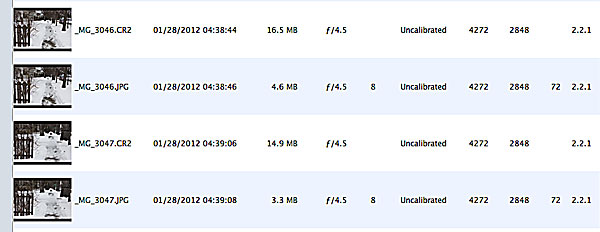 The second format, Camera RAW, normally is not available on compact cameras. But it is standard on Digital Single Lens Reflex (DSLR) cameras. Images obtained in RAW contain every pixel of sensor data unmassaged by software. But they look uglier until pulled into an image editor such as Photoshop and “processed” into a form you can use. And they're a lot larger. How much? Take a look at my comparisons on left: CR2 is the Camera Raw format. Many professionals use Camera RAW only for critical images, because dealing with these take time and a lot of space on a camera’s memory card.
The second format, Camera RAW, normally is not available on compact cameras. But it is standard on Digital Single Lens Reflex (DSLR) cameras. Images obtained in RAW contain every pixel of sensor data unmassaged by software. But they look uglier until pulled into an image editor such as Photoshop and “processed” into a form you can use. And they're a lot larger. How much? Take a look at my comparisons on left: CR2 is the Camera Raw format. Many professionals use Camera RAW only for critical images, because dealing with these take time and a lot of space on a camera’s memory card.
Camera Raw in Bridge
Both Photoshop and Bridge have options to bring photographs into the Camera Raw manipulation software. But here’s the thing a lot of people don’t know: you don’t have to use Camera Raw in Bridge or Photoshop only to edit RAW images!
In fact, you can use it to edit JPG (or TIFF, for that matter, another common format), as an alternative to Photoshop’s standard photo editing options.
Why would you want to do this? Some photographers choose it because they think it's easier, faster, and does a better job. I don’t know about that last one, but I do happen to think it’s easier and faster. So why not give it a try?
The workflow procedure below is based on Scott Kelby’s The Adobe Photoshop Book for Photographers. This text includes a treasury of cool techniques—I’d recommend it. But specifically talking about Camera Raw as a photo editing alternative, here are some ideas based on my own experiences as well as Kelby’s.
![]() 1. First you need to open your (probably) JPG in Camera Raw. If you double-click on a RAW image in Bridge (Adobe’s photo sorting program), it will automatically open in Camera Raw. A JPG will not. The easiest way to open it in Raw is to choose the image in Bridge, and then under the File pulldown, choose Open in Camera Raw. Or you can merely click on the tiny aperture icon at top left of Bridge menu bar, as circled in the illustration (hover over options for descriptions).
1. First you need to open your (probably) JPG in Camera Raw. If you double-click on a RAW image in Bridge (Adobe’s photo sorting program), it will automatically open in Camera Raw. A JPG will not. The easiest way to open it in Raw is to choose the image in Bridge, and then under the File pulldown, choose Open in Camera Raw. Or you can merely click on the tiny aperture icon at top left of Bridge menu bar, as circled in the illustration (hover over options for descriptions).
2. The sample photo below opened in Camera Raw is typical of those taken with the digital camera’s white balance set on Auto. It’s not quite right. In this case, the photo was taken in shade, so it’s a little blue. We’ll start by fixing the color balance.
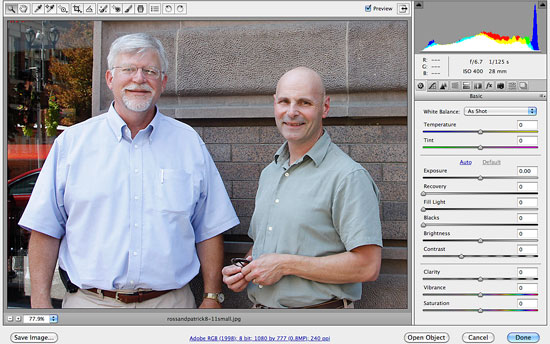 3. Note a great thing about Camera Raw in Bridge is that all your adjustments are right there in a handy toolbox at the right. White Balance is at the top of the list. Apparently Adobe developers considered that to be the first thing you’d want to correct, because if you have a photo that’s not color corrected, it’s more difficult to get a good read on exposure (darkness/lightness). While I don’t instinctively jump to white balance as Job One, perhaps I should. So let’s.
3. Note a great thing about Camera Raw in Bridge is that all your adjustments are right there in a handy toolbox at the right. White Balance is at the top of the list. Apparently Adobe developers considered that to be the first thing you’d want to correct, because if you have a photo that’s not color corrected, it’s more difficult to get a good read on exposure (darkness/lightness). While I don’t instinctively jump to white balance as Job One, perhaps I should. So let’s.
4. You might begin by wondering if the Camera Raw software is smarter than your eye. Depends; photo adjustment is an art, really, and what looks good to you may not look good to the next shooter. But you can use technology to aid art.
In this case, we can clearly see by the histogram at top that this photo is blue-heavy. What’s more, those dark triangles warn us of clipping in both the highlight and shadow areas. “Clipping” in digital photography is what we used to call blown highlights or blocked-up shadows. That is, paper white or ink black with to detail, no ability to see anything in the light and dark areas.
The ideal photograph contains detail in both highlight and shadow areas, with the exception of a few spectral highlights—the glint off chrome, for example—and black shadows—the keyhole in the door. We do need a little jet black and paper white to give the photo snap. But not too much.
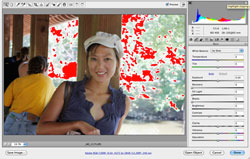 How much clipping do we have in this photo, really? Click once on a triangle at the top of the histogram to find out. It will turn on the clipping areas by showing them in red (or blue for shadows). In fact, this photo shows clipping only the clip--of the pen in Patrick’s pocket. Hardly a problem.
How much clipping do we have in this photo, really? Click once on a triangle at the top of the histogram to find out. It will turn on the clipping areas by showing them in red (or blue for shadows). In fact, this photo shows clipping only the clip--of the pen in Patrick’s pocket. Hardly a problem.
We’re not always so lucky. Take, for example, this image shot in bright backlight. Those red blocks show substantial blown highlights.
But going back to our original bluish image, Let’s correct the color first. You can do this most easily by letting Camera Raw figure it out: Choose Auto from the White Balance flyout menu.
Actually, that’s pretty good. But it is a bit yellow to me. I’m going to move the color Temperature slider down just a little to cool it off slightly. Perfect!
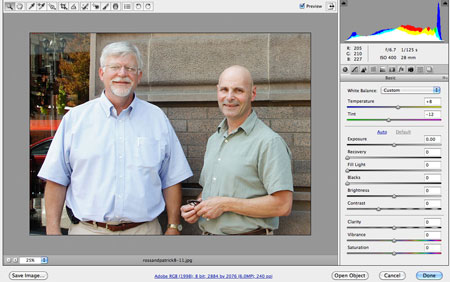 Slider note: You can go back to the default setting by double-clicking on the slider.
Slider note: You can go back to the default setting by double-clicking on the slider.
5. Let’s move on to Exposure. We can use Exposure to adjust the highlights (and Blacks to adjust the shadows). We talked about the problem of clipping, that is, blown out highlights. We’re going to take a look at a different image to see a real problem area we have to deal with. In the example below we note the river and sky are nearly paper white, based on the clipping indications. We need detail, particularly in the river. I could try the Auto exposure option, but this time the software isn’t so smart—the highlights get even whiter.
I’m going to try to darken the image by running the Exposure slider to the left. Well, I fixed the clipping, but now the photo is really too dark.
We want to pull back (recover) some of the spectral highlights. Pull the Recovery slider to the right until the image returns to an exposure that looks good to you.
 In theory we’re supposed to pull the Exposure slider until the white clipping warning triangle goes away. In this case, though, I can’t do that, as the sky is just too white. We’ll have to compromise.
In theory we’re supposed to pull the Exposure slider until the white clipping warning triangle goes away. In this case, though, I can’t do that, as the sky is just too white. We’ll have to compromise.
6. The shadow areas can be deepened using the Blacks slider. Dragging to the right seems to make the color more saturated—a principle also used in color printing. We add black to snap up (saturate) the other colors. This can really improve a flat photo.
Although it does sap a little detail from the shadows, some of this is an all-right trade-off, if the shadow areas are not significant to the detail of the photo. Below is the adjusted photo, admitting the sky is still pretty light.
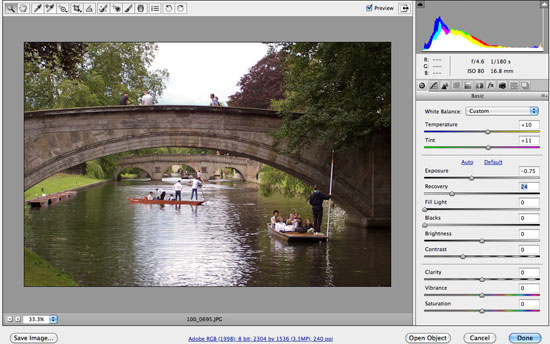 7. Kelby has used the comparison of “midtones” in Photoshop’s Levels to explain how the Brightness slider works, and I like that idea. You can use it to add a little snap to the midtone detail, although I don’t use it as much as I do in Photoshop.
7. Kelby has used the comparison of “midtones” in Photoshop’s Levels to explain how the Brightness slider works, and I like that idea. You can use it to add a little snap to the midtone detail, although I don’t use it as much as I do in Photoshop.
8. Clarity is one cool slider, man. It’s kind of like Photoshop's Unsharp Mask, except it doesn’t work in the same way, so you don’t have the possibility of sharpening to annoying graininess. Try Clarity at +40 or so to give those midtones some pizzazz. If your photo has a lot of detail, you can crank it up even higher. Boy, don’t I wish I had something like this in my old darkroom days.
You actually can drag the slider the other way to soften—this is helpful for people’s faces, on which you don’t want to emphasize every little fine wrinkle the way the new HD TVs to cruelly tend to do.
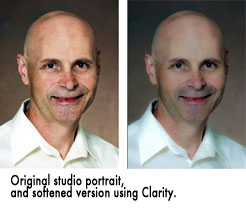
A workflow example.
Below is a photo in original form, and after adjustments. You may not prefer the final look that I prefer. That's why photography is an art.
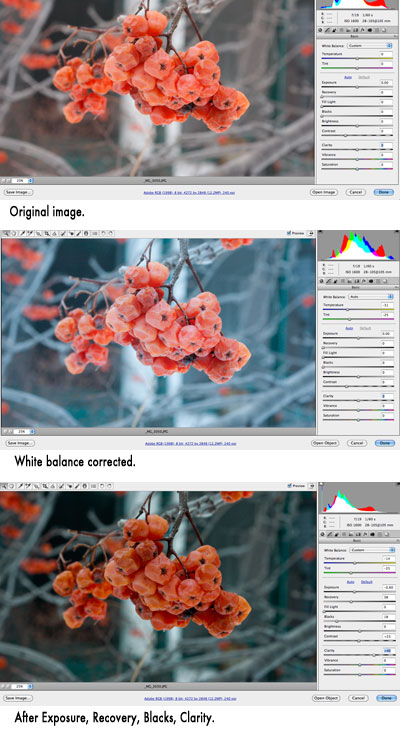
9. Backlighting.
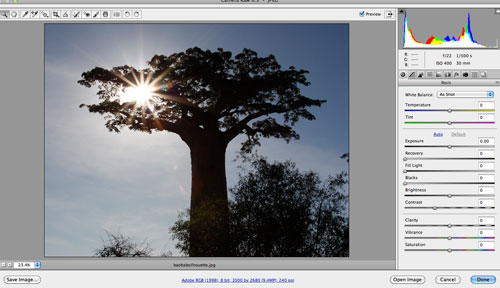 Man, I know we’re supposed to use fill-in flash to open up the shadows on backlit images. But what if you don’t happen to remember that? Or worse, happen to be taking a photo of a huge baobob tree that your little fill-in flash just won’t cover?
Man, I know we’re supposed to use fill-in flash to open up the shadows on backlit images. But what if you don’t happen to remember that? Or worse, happen to be taking a photo of a huge baobob tree that your little fill-in flash just won’t cover?
We could use Photoshop’s Shadow/Highlight adjustment. It’s a bit tricky. Or…we could use the cleverly named Fill Light slider in Camera Raw.
Well, ol' baobab is silhouetted in the setting sun. Obviously lots of clipping going on here in the shadows, as you can see from the histogram. Actually, I deliberately exposed it as a silhouette.
But we do have options. I choose the Auto white balance. Then I cranked on the Fill Light slider to 63. Amazing! Digital photography gives us detail in a detail-less silhouette. If you think the shadows look a little washed out, tweak the Blacks slider to the right a bit.
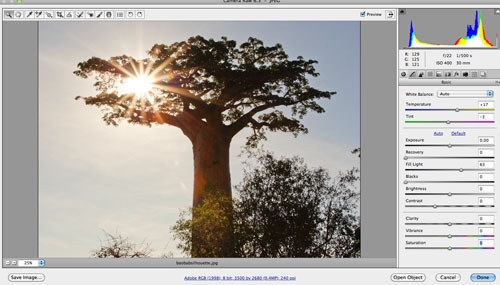
10. Contrast.
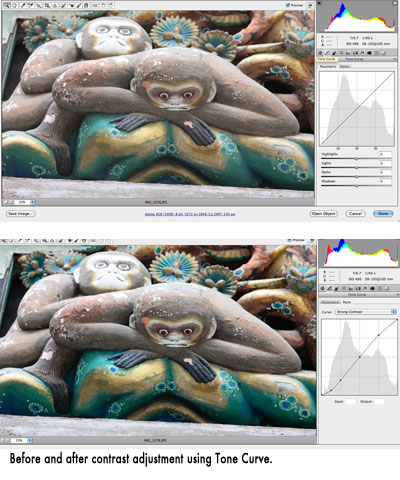 Contrast is the difference between the dark and light areas of a photo. A contrasty photo is normally taken in sunlight or strong spotlight. A flat photo is normally taken on a cloudy day or under florescent light. (See Ross’s Qualities of Light tutorial). While I don't always work with contrast after dealing with the aspects above, you just might want a contrastier (or less likely, a flatter) photo.
Contrast is the difference between the dark and light areas of a photo. A contrasty photo is normally taken in sunlight or strong spotlight. A flat photo is normally taken on a cloudy day or under florescent light. (See Ross’s Qualities of Light tutorial). While I don't always work with contrast after dealing with the aspects above, you just might want a contrastier (or less likely, a flatter) photo.
The Contrast slider is one way to achieve that, although not as persnickety as the Tone Curve tool, that second icon from the left next to the camera iris. You can choose the curve and either adjust contrast on your own with the Parametric option and the sliders, or you can use the Point option and drag the curve around as you’d to in Photoshop’s Curves adjustment.
Or! You can choose the Point tab, and on the curve flyout choose a contrast: Medium or Strong. As often is the case, Photoshop may well be smarter than its users.
Final touches
I’m not going to further belabor the Camera Raw image adjustment option, as this is not a full textbook. But I do happen to like it as an alternative to the usual workflow I described in Tutorial Two.
You also can crop and straighten in Camera Raw, fairly straightforward. To accept the crop, click on another tool. To cleara crop, go back to Crop tool, choose Clear Crop.
After you’re, done, you an choose Open Image to open image in Photoshop, or Done to save changes without opening image. If you want to save changes but keep your original (jpgs or tifs), choose Save Image… and save with a new filename.
Try it yourself!
Download this photo. Adjust as indicated above. Try the Fill light slider to bring detail into the near-silhouettes. And straighten it out, using the horizon line tutorial. After practicing with this photo, choose one of your own photos to submit for grading; submit jpg of original, and photo following your work using this Camera RAW feature in Bridge.